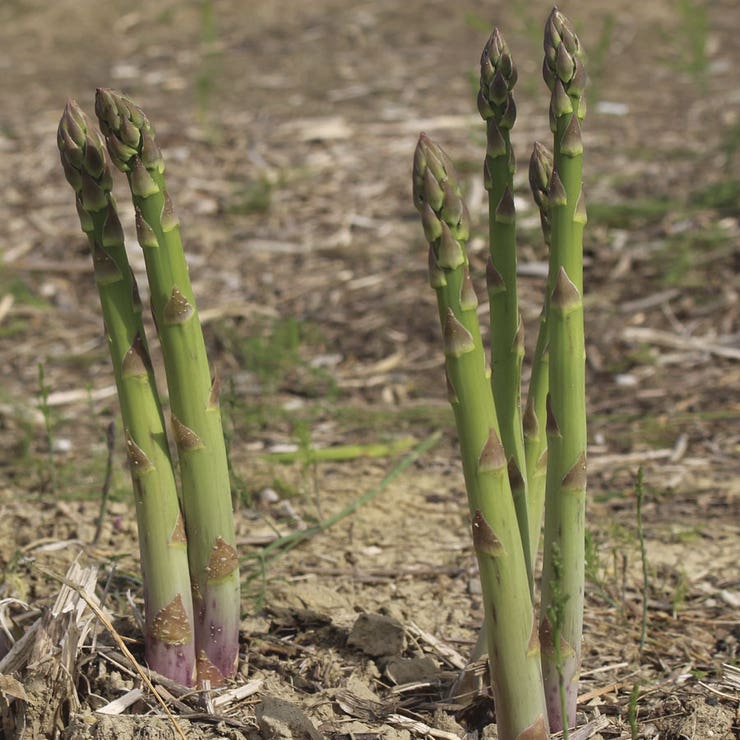Asparagus 'Mary Washington'

In stock
| Ships according to schedule- Buy 3 for $31.50 each and save 10%
Description / Asparagus 'Mary Washington'
An heirloom asparagus variety, 'Mary Washington' is a stem vegetable. An early, high-yielding cultivar, the plant produces long, straight, dark green shoots with tight tips and a delicate, fresh flavor. For best flavor and texture, harvest shoots in early spring while very young, about 5 to 7 inches long. Asparagus spears can be boiled, braised, roasted, steamed, stir fried, or grilled. Asparagus is considered a superfood for its nutrient rich content, having a high (top 20) Aggregate Nutrient Density Index score (ANDI), or micronutrient-per-calorie density. It is a good source of vitamins B6, C, and K, fiber, niacin, thiamin, and riboflavin. It also contains a range of phytonutrients.
'Mary Washington', a long-lived, herbaceous perennial, is a member of the asparagus family (Asparagaceae). The plant self-propagates by rhizomatous roots. Dioecious, asparagus requires cross-pollination of 2 separate plants, a male and female, for fruit production. Once established, the plant can produce for decades with proper care, but it should not be harvested until the second year.
If asparagus is not harvested, the plant produces a towering fern of attractive feathery foliage of very branched tiny, linear leaves that turn yellow in fall and eventually die back naturally. 'Mary Washington' is a female selection and may also produce ornamental red berries. The berries are toxic and should not be eaten. The plants have ornamental value and are suitable for edible landscapes.
'Mary Washington' is easy to grow. It prefers full sun and loose, organically rich, evenly moist, sandy, well-drained soil with a neutral pH of 6.0 to 7.0 and that is free of weeds. Top dress with compost and apply nitrogen yearly, in early spring. It grows best in cooler locales with long winters. Mary Washington is asparagus rust, fusarium, crown rot and rabbit resistant.
A cool-season vegetable, one of the first to be planted in the garden, asparagus seed can be direct sown into the garden in early spring, 2 to 4 weeks before the last frost date. It can also be started indoors 8 to 10 weeks before transplanting in the garden when the soil reaches a temperature of 60 to 65°F. Mulching helps to moderate soil temperature as well as to maintain soil moisture and control weeds. Protect plants with row covers if temperatures are expected to dip below 20°F.
If you plan to start your seeds indoors, be sure to check out our Bio Dome Seed Starter Kit. With the Bio Dome, you can control the temperature, light, and soil mix to ensure your seeds become strong for transplant.
Product Details
| Item Form | Bareroot |
|---|---|
| Genus | Asparagus |
| Species | officinalis |
| Variety | Mary Washington |
| Product Classification | Vegetables |
| Habit | Upright |
| USDA Zone Low | 3 |
| USDA Zone High | 8 |
| Sun / Shade | Full Sun, Part Shade |
| Bloom Season Start | Late Winter |
| Bloom Season End | Late Spring |
| Foliage Color | Medium Green |
| Harvest Season | Early Spring |
| Resistance | Crown Rot, Fusarium Wilt, Fusarium Yellows, Rust |
| Special Features | Bloom First Year, Easy Care Plants, Edible, Heirloom |
| Uses | Beds, Border, Containers, Cuisine, Cut Flowers, Foliage Interest |
| Zone | 3, 4, 5, 6, 7, 8 |
| State Shipping Restrictions | GU, PR, VI |
| Discount Exempt | No |




